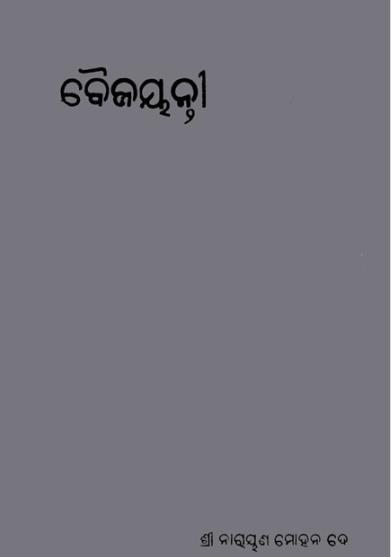In the heart of Odia literature, the year 1940 witnessed the emergence of a poetic gem: Baijaanti by the esteemed poet Narayana Mohan De. This collection, named after the renowned flowering plant, is not just a bouquet of verses but a rich tapestry of emotions, cultural reflections, and profound philosophical musings. As one of the significant contributions to Odia poetry, Baijayanti invites readers to explore the delicate interplay between nature and human experience.
Narayana Mohan De, a prominent figure in the Odia literary landscape, adeptly captures the essence of life and its myriad facets through his poetic lens. In Baijayanti, he employs a diverse range of themes, including love, nature, spirituality, and the intricate connections that bind humanity to the cosmos. His verses resonate with a lyrical beauty that transcends time, making the reading experience both enchanting and thought-provoking.
One of the most striking features of Baijayanti is De’s evocative use of imagery. The poet draws parallels between the vibrant hues of nature and the complexities of human emotions. His descriptions of landscapes, flowers, and seasonal changes serve as metaphors for love, longing, and the passage of time. For instance, the baijayanti flower, known for its beauty and fragility, symbolizes the transient yet exquisite nature of human relationships. Through this symbolism, De encourages readers to appreciate the fleeting moments of beauty in life, prompting reflections on love and loss.
Furthermore, Baijayanti addresses the deep connection between nature and spirituality. De often invokes the serenity of natural settings as spaces for introspection and spiritual awakening. His verses invite readers to contemplate their place within the vast universe, fostering a sense of reverence for both nature and the divine. This emphasis on spirituality aligns with traditional Odia thought, where nature is often viewed as a manifestation of the divine and a source of inspiration and solace.
The rhythmic qualities of De’s poetry further enhance the impact of Baijayanti. His command of language is evident in the seamless flow of words and the melodic structure of his verses. This musicality not only captures the ear but also evokes emotion, creating a deeper connection between the reader and the text. De’s style reflects a mastery of Odia poetic traditions, blending classical influences with contemporary sensibilities, which resonates with a diverse readership.
In addition to its aesthetic and emotional depth, Baijayanti also stands as a cultural artifact that reflects the socio-political environment of 1940s Odisha. The backdrop of the book is situated within a period of change, and De subtly weaves themes of hope and resilience throughout his poetry. The poet’s celebration of local culture and heritage is an act of resistance against colonial domination, echoing the sentiments of pride and identity that characterized the era.
As we delve into Baijayanti, we uncover not just the beauty of Narayana Mohan De’s language, but also the timeless wisdom embedded within his poetry. The themes of love, nature, and spirituality resonate with contemporary readers, reminding us of the enduring human experience across generations. In a world often marked by chaos and uncertainty, De’s verses invite reflection and appreciation for the moments of beauty that life offers.
Books Info
| Books name | Baijayanti/ବୈଜୟନ୍ତୀ |
| Author | Narayana Mohan De |
| No Of pages | 169 |
| Publisher | Sri Narayana Mohan De |
| Publication | 1940 |
| Printed At | The Utkal Sahitya Press |
| Distributor | NA |

